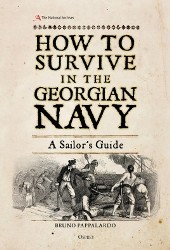 Pirates and Privateers Pirates and Privateers
The History of Maritime
Piracy
Cindy Vallar, Editor
& Reviewer
P.O. Box 425,
Keller, TX 76244-0425
    
Books for
Adults ~ History: Navy (United Kingdom)

How to Survive in the
Georgian Navy: A Sailor’s Guide
by Bruno Pappalardo
Osprey, 2019, ISBN 978-1-4728-3087-6, UK £8.99 / US
$15.00 / CAN $20.00
    
Divided
into ten chapters, How to Survive in the
Georgian Navy introduces readers to a wide
range of topics concerning life in the Royal Navy
during the reigns of George I, II, III, and IV. When
the War of the Spanish Succession ends in 1715,
Britain possesses more naval ships than any other
European nation. Her merchant trade is expanding to
encompass the entire world and the ships carrying
imports and exports require protection, which
necessitates a naval presence in the far reaches of
the British Empire. This, in turn, requires both
financial backing and a good infrastructure to
support the ships and crews stationed in these
distant ports and waters.
Chapter one focuses on the navy’s personnel,
officers and ratings alike, and what they do aboard
the ships. The next chapter is concerned with how
these men join the Royal Navy. War necessitates a
large number of men, but in times of peace, far
fewer are needed. For example, at the time that the
wars with France ends in the early 19th century,
145,000 men serve in the Royal Navy. The majority
(126,000 to be precise) soon find themselves
unemployed.
It is important that a ship’s crew work together;
rules and regulations provide for the smooth running
of the ships and, as a result, sometimes require men
to be disciplined. This is the topic of chapter
three: Crimes and Punishment: Discipline in the
Georgian Navy. The flip side of this is the need to
not only feed the crew and allow them periods of
downtime but also to maintain their health. The
latter is particularly important since the majority
of deaths stem from disease or accident. For
example, one in thirty-one men die each year as a
result of these two culprits between 1792 and 1815,
whereas one in 403 succumb in battle. These are the
topics discussed in chapters four and five: Victuals
and Time Out: Food, Drink and Recreation in the
Georgian Navy, and Keeping a Healthy Crew: Medicine
in the Georgian Navy.
During an eighty-one year period, beginning in 1714,
the navy loses 1,027 ships. More than half of these
founder; the rest are the result of wrecking, fire,
colliding, or mutiny. While chapter nine
specifically examines “Mutiny in the Georgian Navy,”
chapter six explores “A Matter of Survival: Storms,
Shipwreck and Fire on Board Ship.” Chapter seven
discusses naval expeditions of a scientific nature,
whereas chapter eight concerns warships and sea
battles. The latter includes firsthand accounts of
the battles of Cape Passaro (1718), at Finisterre
(1747), and of Quiberon Bay (1759). Most such
accounts come from a ship’s officers, but the author
also includes one written by an ordinary seaman who
was aboard HMS Orion during the Battle of
the Nile in 1798.
The last chapter talks about “Women at Sea in the
Age of Sail.” Often seen as bad luck, the historical
record mentions that in 1379, the French attack
during a bad storm. The sailors blame the sixty
women who are aboard and toss them into the roiling
sea. Some are of questionable character, but others
are members of the upper crust. Between the 17th and
19th centuries, they can be found on navy ships,
sometimes to entertain the men who an’t allowed
shore leave. Other times, women actually work in
some semi- or unofficial capacity, or find
themselves aboard because they are fleeing from
enemy troops. A minority choose to disguise
themselves in male attire and join the navy.
The epilogue discusses the Georgian navy’s legacy
during a critical period in history. As Pappalardo
writes, “aided by both the technological advances of
the equipment and techniques and the attitude,
training and skill of the men of the Royal Navy . .
. gained Britain undisputed supremacy of the seas
for the next century and firmly established Britain
as a leading global power.” (136)
Interspersed throughout the 144 pages are
black-&-white illustrations. The endpapers are
in full color. The front depicts the two halves of
the world; the back is a painting of Admiral Earl
Howe’s victory over the French fleet on the Glorious
First of June 1794. The use of a very small font
size is the only drawback, but to use a larger one
will have necessitated making a book of either
greater dimensions or additional length. This volume
also contains a Timeline of Major Naval Battles and
Events, a bibliography, and an index.
Pappalardo, Principal Records Specialist (Naval) at
The National Archives in London, packs a wealth of
knowledge into this pocket-sized, hardback book that
is entertaining and informative. The narrative is
both a historical introduction to the Royal Navy
between 1714 and 1820, and a collection of
contemporary, illustrative quotations from the
officers and men who serve aboard British warships
or in administrative capacities. How to Survive
in the Georgian Navy is an excellent overview
for those unfamiliar with this period of British
naval history, or an exceptional summary for those
seeking to reacquaint themselves with it.
Review
Copyright ©2019 Cindy
Vallar

Click to contact me
Background image compliments
of Anke's Graphics |

